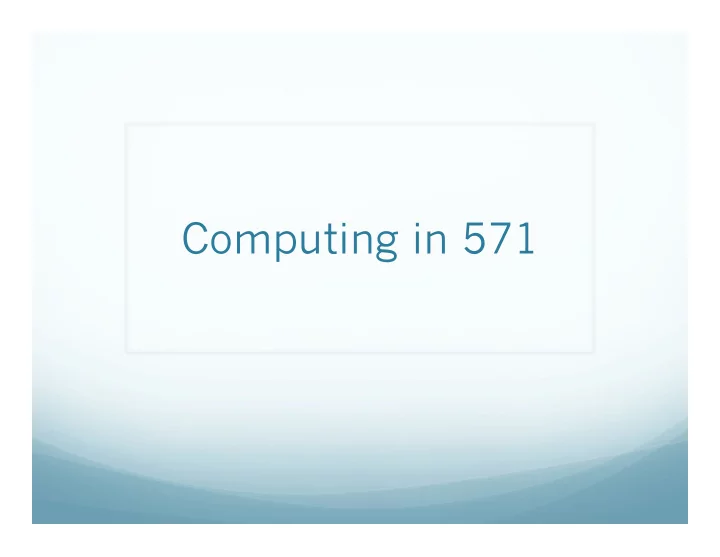

Computing in 571
Programming For standalone code, you can use anything you like That runs on the department cluster For some exercises, we will use a Python-based toolkit
Department Cluster Resources on CLMS wiki http://depts.washington.edu/uwcl Installed corpora, software, etc. patas.ling.washington.edu dryas.ling.washington.edu If you don’t have a cluster account, request one ASAP! Link to account request form on wiki https://vervet.ling.washington.edu/db/accountrequest- form.php
Condor Distributes software processes to cluster nodes All homework will be tested with condor_submit See documentation on CLMS wiki Construction of condor scripts http://depts.washington.edu/uwcl/twiki/bin/view.cgi/ Main/HowToUseCondor
NLTK Natural Language Toolkit (NLTK) Large, integrated, fairly comprehensive Stemmers Taggers Parsers Semantic analysis Corpus samples, etc Extensively documented Pedagogically oriented Implementations strive for clarity Sometimes at the expense of speed/efficiency
NLTK Information http://www.nltk.org Online book Demos of software HOWTOs for specific components API information, etc
Python & NLTK NLTK is installed on cluster Use python3.4 with NLTK NOTE: This is not the default!!! May use python2.7, but some differences NLTK data is also installed /corpora/nltk/nltk-data NLTK is written in Python http://www.python.org; http://docs.python.org Many good online intros, fairly simple
Python & NLTK Interactive mode allows experimentation, introspection patas$ python3.4 >>> import nltk >>> dir(nltk) ….. AbstractLazySequence', 'AffixTagger', 'AnnotationTask', 'Assignment', 'BigramAssocMeasures', 'BigramCollocationFinder', 'BigramTagger', 'BinaryMaxentFeatureEncoding', >>> help(nltk.AffixTagger) …… Prints properties, methods, comments,…
Turning in Homework Class CollectIt Linked from course webpage Homeworks due Tuesday night CollectIt time = Tuesday 23:45 Should submit as hw#.tar Where # = homework number Tar file contains top-level condor scripts to run
HW #1 Create a CFG to cover a small sentence corpus Use NLTK to parse those sentences Goals: Set up software environment for course Practice CFG writing Gain basic familiarity with NLTK
HW #1 Useful tools: Loading data: nltk.data.load (resource_url ) Reads in and processes formatted cfg/fcfg/treebank/etc Returns a grammar from cfg E.g. nltk.data.load(“grammars/sample_grammars/toy.cfg”) Load nltk built-in grammar nltk.data.load(“file://+path_to_my_grammar_file) Load my grammar file from specified path Tokenization: nltk.word_tokenize(mystring) Returns array of tokens in string
HW #1 Useful tools: Parsing: parser = nltk.parse.EarleyChartParser(grammar) Returns parser based on the grammar parser.parse(token_list) Returns iterable list of parses for item in parser.parse(tokens): print(item) (S (NP (Det the) (N dog)) (VP (V chased) (NP (Det the) (N cat))))
Recommend
More recommend